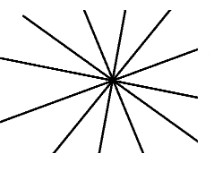
Select the wrong statement from the following.
A.Only one line can pass through a single point.
B.Only one line can pass through two distinct points
C.A terminated line can be produced indefinitely on both the sides
D.If two circles are equal, then their radii are equal
Answer
553.2k+ views
Hint: A line segment is bounded in geometry by two distinct points on a line. Or we can say the section of the line that connects to points is a line segment. In all directions, a line has no endpoints and extends indefinitely, but a line section has two fixed or definite endpoints. The section of the line and the ray differ in that a ray has only one endpoint, which is its point of departure.
Complete step-by-step answer:
First consider the statement (A), it is given only one line can pass through a single point, but if we observe the diagram below,

We can see that we can draw an infinite number of lines through a point. Therefore statement (A) is wrong.
Now, consider statement (B), it is given that only one line can pass through two distinct points, observe the below diagram,

Here, we can see only one line passes through A, B, therefore, if given two distinct points, there is a unique line passing through them, so this statement is true.
Now, consider statement (C), it is given that a terminated line can be produced indefinitely on both the sides, consider the diagram below,

In the above diagram we can see that the line segment AB can be extended from both the sides indefinitely, so this statement is true.
Now, consider statement (D), it is given that if two circles are equal, then their radii are equal
If two circles are equal, then the area of these two circles are also equal, let the radius of 1st circle be $ {r_1} $ and the radius of 2nd circle be $ {r_2} $ .
So,
$
\Rightarrow \pi {r_1}^2 = \pi {r_2}^2 \\
\Rightarrow {r_1}^2 = {r_2}^2 \\
\Rightarrow {r_1} = {r_2} \\
$
Therefore, if two circles are equal, then their radii are equal, so statement (D) is correct.
So, the Wrong option is “Option A”.
Note: A line, which has length but no width, is a one-dimensional figure. A line is composed of a set of points that are infinitely extended in opposite directions. In a two-dimensional plane, it is defined by two lines. Collinear points are said to be the two points which lie on the same side. Different kinds of lines occur in geometry, such as horizontal and vertical lines parallel and perpendicular lines.
Complete step-by-step answer:
First consider the statement (A), it is given only one line can pass through a single point, but if we observe the diagram below,

We can see that we can draw an infinite number of lines through a point. Therefore statement (A) is wrong.
Now, consider statement (B), it is given that only one line can pass through two distinct points, observe the below diagram,

Here, we can see only one line passes through A, B, therefore, if given two distinct points, there is a unique line passing through them, so this statement is true.
Now, consider statement (C), it is given that a terminated line can be produced indefinitely on both the sides, consider the diagram below,

In the above diagram we can see that the line segment AB can be extended from both the sides indefinitely, so this statement is true.
Now, consider statement (D), it is given that if two circles are equal, then their radii are equal
If two circles are equal, then the area of these two circles are also equal, let the radius of 1st circle be $ {r_1} $ and the radius of 2nd circle be $ {r_2} $ .
So,
$
\Rightarrow \pi {r_1}^2 = \pi {r_2}^2 \\
\Rightarrow {r_1}^2 = {r_2}^2 \\
\Rightarrow {r_1} = {r_2} \\
$
Therefore, if two circles are equal, then their radii are equal, so statement (D) is correct.
So, the Wrong option is “Option A”.
Note: A line, which has length but no width, is a one-dimensional figure. A line is composed of a set of points that are infinitely extended in opposite directions. In a two-dimensional plane, it is defined by two lines. Collinear points are said to be the two points which lie on the same side. Different kinds of lines occur in geometry, such as horizontal and vertical lines parallel and perpendicular lines.
Recently Updated Pages
Master Class 12 Business Studies: Engaging Questions & Answers for Success

Master Class 12 Economics: Engaging Questions & Answers for Success

Master Class 12 English: Engaging Questions & Answers for Success

Master Class 12 Maths: Engaging Questions & Answers for Success

Master Class 12 Social Science: Engaging Questions & Answers for Success

Master Class 12 Chemistry: Engaging Questions & Answers for Success

Trending doubts
What is BLO What is the full form of BLO class 8 social science CBSE

Which one of the following groups comprises states class 8 social science CBSE

Citizens of India can vote at the age of A 18 years class 8 social science CBSE

Full form of STD, ISD and PCO

A couple went for a picnic They have 5 sons and each class 8 maths CBSE

Right to vote is a AFundamental Right BFundamental class 8 social science CBSE




